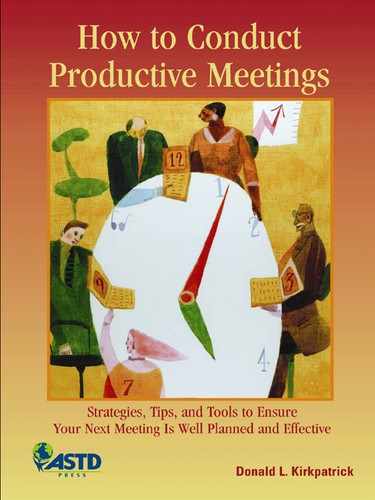Chapter 2
The Costs and Causes of a Nonproductive Meeting
![]()
Expert and consultant on time management, R. Alec Mackenzie, conducted a study to determine the most significant timewasters in industry, business, and government. Table 2-1 lists timewaster profiles of five specific groups he studied. Each participant was asked to make a list of the top 10 personal timewasters in order of importance. The “No.” column indicates the total number of participants who listed that item in their top 10 list. The “Wt.” column shows the total weights (10 = most important) given by those who selected that item.
In summarizing his research on timewasters, Mackenzie ranked the top 10 in order of significance:
1. Telephone interruptions
2. Drop-in visitors
3. Meetings
4. Crises
5. Lack of objectives, priorities, and deadlines
6. Cluttered desk and personal disorganization
7. Ineffective delegation and involvement in routine and detail
8. Attempting too much at once and unrealistic time estimates
9. Lack of clear communication or instruction
10. Inadequate, inaccurate, and delayed information
Table 2-1. Timewaster Profile.
According to supervisors and managers, the average amount of wasted time is between 10 percent and 50 percent, depending on the type of meeting. The highest percentage comes from those who attend departmental and staff meetings. The lowest percentage is for training meetings.
Very seldom do people try to determine the cost of a meeting. For anyone interested, a machine, the Econometer, has been built to help compute the cost. It's a Danish-built machine designed to cut down on management meeting addiction by computing the total cost of meetings minute by minute. It considers the number of participants and their average annual salary. Installed in a conference room, the Econometer operates like an electricity meter—the higher the power consumption, the faster the disk rotates and the higher the bill becomes. The hourly prices of the meetings are set on two digital switches: the adjustment range is from $10 to $990 per hour, and the scoreboard covers meeting costs up to $9,900. The same kind of figures could be computed without a machine. And these kinds of figures would make a leader think twice before calling a meeting.
It's much more difficult (if not impossible) to compute the benefits that are derived from a meeting. Usually, the best that can be done is to evaluate subjectively the possible benefits in terms of better results that come from a productive meeting.
To realize the importance of making meetings as productive as possible, look at the waste of time and money if meetings are not effective. Chapter 1 lists three ingredients that make a meeting productive: Objectives are accomplished in minimum time with satisfied participants. Consider the cost if any one of these ingredients is not achieved.
Objectives Were Not Accomplished
The meeting was a failure. To calculate the cost of the meeting, multiply the salary of each person by the time spent and arrive at a dollar cost of the meeting. In addition, add the cost of the time of the leader plus the direct costs of the facilities, materials, aids, food, and so forth.
There may have been some side benefits that would have to be considered, but overall the meeting was a failure and all (or nearly all) of the costs are lost.
Time Was Wasted
Guesstimate the amount of wasted time, and multiply it by the salaries of the attendees to arrive at a dollar figure. Add the cost of other activities that could have been done if the time was not wasted and the meeting ended sooner. Also, add some indirect costs that come from participants who are annoyed and frustrated when time is wasted. It isn't always easy to judge wasted time because there is often a difference of opinion concerning it. For example, if a participant gives a lengthy comment that was not pertinent or could have been said in a few words, the leader or another participant could say it was a waste of time. The participant, however, might have felt that the lengthy explanation was necessary.
Perhaps the best way to determine wasted time is to ask, Did it help to contribute to the accomplishment of the objective? If not, the time was probably wasted.
Participants Were Not Satisfied
The third ingredient of an effective meeting presents a new dimension in judging wasted time.
What is the cost of dissatisfaction on the part of people who leave a meeting? There is no way of measuring it in dollars and cents. However, the cost might be much greater than those costs previously mentioned. Some or all of the following factors may be present:
![]() A participant might resolve
A participant might resolve
— I won't come to the next meeting.
— I won't participate in future meetings if I'm forced to be there.
![]() A participant might determine
A participant might determine
— The leader is ineffective as a person (unprepared, unqualified, inefficient, arbitrary, etc.). This can affect future relationships with the leader and even the department that the leader represents.
— Meetings are a waste of time, and we ought to eliminate them.
All of these thoughts point to negative attitudes and low morale on the part of the participants. These attitudes can result in costly behavior, such as poor productivity, complaints to other people, negative attitudes in future meetings, and even turnover.
